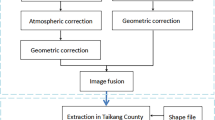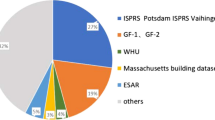Abstract
Semantic segmentation technology is an important step in the interpretation of remote sensing images. High spatial resolution remote sensing images have clear features. Traditional image segmentation methods cannot fully represent the information in high spatial resolution images and tend to yield unsatisfactory segmentation accuracy. With the rapid development of deep learning, many researchers have tried to use deep learning algorithms for remote sensing image segmentation. This paper uses U-Net for multiclassification and binary classification of Gaofen-2 high spatial resolution remote sensing image data. Six types of features, which were build-up, farmland, water, meadow, forest and others, were labeled in the image. A “neighborhood voting” method was used to determine the category of uncertain pixels based on spatial heterogeneity and homogeneity. Through U-Net neural network multiclassification, the overall accuracy of the training data is 93.83%; the overall accuracy of the test data is 82.27%; and the test accuracy of the binary classification algorithm is 79.75%. The results show that the two models yield high accuracy and credibility in remote sensing image segmentation.






Similar content being viewed by others
References
Mboga N, Georganos S, Grippa T et al (2019) Fully convolutional networks and geographic object-based image analysis for the classification of VHR imagery. Remote Sens 11(5):597
Qin Y, Chi M, Liu X et al (2018) Classification of high resolution urban remote sensing images using deep networks by integration of social media photos. In: International geoscience and remote sensing symposium (IGARSS2018), pp 7243–7246
Chaib S, Yao H, Gu Y et al (2017) Deep feature extraction and combination for remote sensing image classification based on pre-trained CNN models. In: International conference on digital image processing (ICDP), pp 104203D
Yuan J, Wang D, Li R (2014) Remote sensing image segmentation by combining spectral and texture features. IEEE Trans Geosci Remote Sens 52(1):16–24
Zhao Q, Zhang S, Huang S (2013) Multi-scale and multi-feature high resolution remote sensing image segmentation. Int J Appl Math Stat 51(22):343–350
Zhang L, Huang X, Huang B et al (2006) A pixel shape index coupled with spectral information for classification of high spatial resolution remotely sensed imagery. IEEE Trans Geosci Remote Sens 44(10):2950–2961
Tuia D, Volpi M, Copa L et al (2011) A survey of active learning algorithms for supervised remote sensing image classification. IEEE J Selected Topics Signal Process 5(3):606–617
Gao J, Xu L (2015) An efficient method to solve the classification problem for remote sensing image. AEU Int J Electr Commun 69(1):198–205
Liu Z, Li X, Luo P et al (2017) Deep learning Markov random field for semantic segmentation. IEEE Trans Pattern Anal Mach Intell 40(8):1814–1828
Hamida A B, Benoit A, Lambert P, et al (2017) Deep learning for semantic segmentation of remote sensing images with rich spectral content. In: International geoscience and remote sensing symposium (IGARSS2017), pp 2569–2572
Lv X, Ming D, Lu T et al (2018) A new method for region-based majority voting CNNs for very high resolution image classification. Remote Sens 10(12):1946
Ce Z, Isabel S, Xin P et al (2018) An object-based convolutional neural network (OCNN) for urban land use classification. Remote Sens Environ 216:57–70
Papadomanolaki M, Vakalopoulou M, Zagoruyko S et al (2016) Benchmarking deep learning frameworks for the classification of very high resolution satellite multispectral data. ISPRS Annals of the Photogrammetry, Remote Sens Spatial Inform Sci, pp 83–88
Xu Y, Du B, Zhang L et al (2018) Multi-source remote sensing data classification via fully convolutional networks and post-classification processing. In: International geoscience and remote sensing symposium (IGARSS2018), pp 3852–3855
Sivagami R, Srihari J, Ravichandran K S et al (2018) Analysis of encoder-decoder based deep learning architectures for semantic segmentation in remote sensing images. In: International conference on intelligent systems design and applications (ISDA), pp 332–341
Iglovikov V, Shvets A (2018) Ternausnet: U-net with vgg11 encoder pre-trained on imagenet for image segmentation. arXiv preprint arXiv:1801.05746
Tong XY, Xia GS, Lu Q et al (2020) Land-cover classification with high-resolution remote sensing images using transferable deep models. Remote Sens Environ 237:111322
Lecun Y, Bottou L (1998) Gradient-based learning applied to document recognition. Proc IEEE 86(11):2278–2324
Hadji I, Wildes RP (2018) What do we understand about convolutional networks?. arXiv preprint arXiv:1803.08834
Krizhevsky A, Sutskever I, Hinton G (2012) ImageNet classification with deep convolutional neural networks. In: Advances in neural information processing systems, pp 1097–1105
Ronneberger O, Fischer P, Brox T (2015) U-Net: convolutional networks for biomedical image segmentation. In: International conference on medical image computing and computer-assisted intervention (MICCA) pp. 234–241
Chen L, Shang S, Yang C et al (2020) Spatial keyword search: a survey. GeoInformatica 24(1):85–106
Chen L, Shang S, Jensen CS et al (2020) Top-k term publish/subscribe for geo-textual data streams. VLDB J 29:1101–1128
Chen L, Shang S (2019) Approximate spatio-temporal top-k publish/subscribe. World Wide Web 22(5):2153–2175
Yang C, Chen L, Shang S et al (2019) Toward efficient navigation of massive-scale geo-textual streams. In: International joint conference on artificial intelligence, pp 4838–4845
Chen L, Shang S, Zheng K et al (2019) An efficient online summarization algorithm for spatio-temporal data streams. In: IEEE international conference on data engineering (ICDE), pp 890–901
Tobler WR (1970) A computer movie simulating urban growth in the Detroit region. Econ Geogr 46:234–240
Csurka G, Larlus D, Perronnin F et al (2013) What is a good evaluation measure for semantic segmentation. In: British machine vision conference (BMVC)
Acknowledgements
This work was supported in part by the National Natural Science Foundation of China (62071439, 61601418, 61871259), in part by the Opening Foundation of Hunan Engineering and Research Center of Natural Resource Investigation and Monitoring (2020-5), in part by the Qilian Mountain National Park Research Center (Qinghai) (Grant Number: GKQ2019-01), and in part by the Geomatics Technology and Application Key Laboratory of Qinghai Province, Grant No. QHDX-2019-01.
Author information
Authors and Affiliations
Corresponding author
Ethics declarations
Conflict of interest
The authors declare that they have no conflict of interest.
Additional information
Publisher's Note
Springer Nature remains neutral with regard to jurisdictional claims in published maps and institutional affiliations.
Rights and permissions
About this article
Cite this article
Zheng, X., Chen, T. High spatial resolution remote sensing image segmentation based on the multiclassification model and the binary classification model. Neural Comput & Applic 35, 3597–3604 (2023). https://doi.org/10.1007/s00521-020-05561-8
Received:
Accepted:
Published:
Issue Date:
DOI: https://doi.org/10.1007/s00521-020-05561-8




